Irisleaf Rush
(Juncus xiphioides)
Irisleaf Rush (Juncus xiphioides)
/
/

Anthony Valois and the National Park Service
Public domain
Image By:
Anthony Valois and the National Park Service
Recorded By:
Copyright:
Public domain
Copyright Notice:
Photo by: Anthony Valois and the National Park Service | License Type: Public domain | License URL: https://creativecommons.org/public-domain/ | Uploader: Stickpen | Publisher: Wikimedia Commons | Title: Juncusxiphioides.jpg | Notes: |













Estimated Native Range
Summary
Juncus xiphioides, commonly known as Irisleaf Rush, is an evergreen perennial grass native to wetlands, including marshes, stream banks, and moist meadows in the Southwestern USA and Northwestern Mexico. It typically grows to a height of 40 to 80 centimeters with wide leaf blades that are unusual for a rush, often exceeding one centimeter in width at the base. The straw-colored leaves can reach up to 40 centimeters in length. Its large inflorescence boasts many clusters of up to 70 flowers each, with very narrow green, red, or yellow-brown, lance-shaped tepals and six stamens with very small anthers. The fruit is a brown oblong capsule. In its native habitat, Irisleaf Rush plays a role in stabilizing soil and providing habitat for wildlife.
Irisleaf Rush is valued for its structural form and textural contrast in gardens, particularly in water features, native plant gardens, and natural landscaping designs. It thrives in full sun, requiring high amounts of water, and prefers soils with slow drainage, making it suitable for wet areas where other plants might struggle. It is often used to naturalize areas or create a vertical element in water gardens. While it is generally low-maintenance, it can spread if conditions are ideal, so gardeners should monitor its growth to prevent unwanted expansion.CC BY-SA 4.0
Irisleaf Rush is valued for its structural form and textural contrast in gardens, particularly in water features, native plant gardens, and natural landscaping designs. It thrives in full sun, requiring high amounts of water, and prefers soils with slow drainage, making it suitable for wet areas where other plants might struggle. It is often used to naturalize areas or create a vertical element in water gardens. While it is generally low-maintenance, it can spread if conditions are ideal, so gardeners should monitor its growth to prevent unwanted expansion.CC BY-SA 4.0
Plant Description
- Plant Type: Herb
- Height: 2-3 feet
- Width: 1.5-6 feet
- Growth Rate: Rapid
- Flower Color: N/A
- Flowering Season: Fall, Spring, Summer
- Leaf Retention: Evergreen
Growth Requirements
- Sun: Full Sun
- Water: High
- Drainage: Slow
Common Uses
Butterfly Garden, Deer Resistant, Drought Tolerant, Erosion Control, Low Maintenance, Street Planting
Natural Habitat
Wetlands, including marshes, stream banks, and moist meadows
Other Names
Common Names:
Scientific Names: , Juncus xiphioides, Juncus xiphioides var. littoralis, Juncus xiphioides var. auratus,
GBIF Accepted Name: Juncus xiphioides E.Mey.